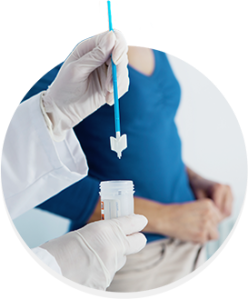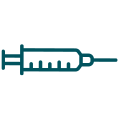
Protection against HPV-related cancers and genital warts
Spread the word about HPV prevention – not the virus
According to The Society of Obstetricians and Gynaecologists of Canada, the only way to totally protect against HPV is to completely abstain from any sexual activity that involves genital contact – a fairly unrealistic option.
Short of total protection, there is a benefit to protecting yourself to the best of your ability, regardless of whether you are currently sexually active, or whether or not you have already been infected with HPV.
Listed below are certain steps you can take to help protect yourself and help decrease your risk of contracting or transmitting HPV.

It’s a fact… Cervical cancer may be prevented with regular Pap tests and HPV vaccination. HPV vaccination also helps prevent other HPV-related diseases like genital warts.
It’s a fact… In 2012, oropharyngeal cancer was the most common HPV-related cancer in Canada (1,335 cases of oropharyngeal cancer, followed by 1,300 cases of cervical cancer and 475 cases of anal


It’s a fact… Anal cancer, or cancer of the anus, is rare but increasing. The HPV type most commonly associated with anal cancer is HPV 16.
It’s a fact… It’s estimated that 75% of sexually active Canadians will have at least one HPV infection in their lifetime.

Safety Information
GARDASIL®9 is a vaccine indicated for individuals 9 through 45 years of age for the prevention of infection caused by the human papillomavirus (HPV) types 6, 11, 16, 18, 31, 33, 45, 52 and 58 and the following diseases associated with the HPV types included in the vaccine: certain head and neck cancers, such as throat and back of mouth cancers, caused by HPV types 16, 18, 31, 33, 45, 52, and 58. GARDASIL®9 has been approved with conditions. This means it has passed Health Canada’s review and can be bought and sold in Canada, but the manufacturer has agreed to complete more studies to make sure the vaccine works the way it should. For more information, talk to your healthcare professional.
GARDASIL®9 is also indicated for individuals 9 through 45 years of age for the prevention of infection caused by the human papillomavirus (HPV) types 6, 11, 16, 18, 31, 33, 45, 52 and 58 and the following diseases associated with the HPV types included in the vaccine: cervical, vulvar, vaginal and anal cancer caused by HPV types 16, 18, 31, 33, 45, 52, and 58; genital warts (condyloma acuminata) caused by HPV types 6 and 11; abnormal and precancerous cervical lesions (changes in cells of the cervix that have a risk of turning into cancer) as found in a Pap test caused by HPV types 6, 11, 16, 18, 31, 33, 45, 52 and 58; abnormal and precancerous vaginal, vulvar (outside of the female genital area) and anal lesions caused by HPV types 6, 11, 16, 18, 31, 33, 45, 52 and 58.
GARDASIL®9 does not protect the person getting the vaccine from a disease that is caused by other types of HPV, other viruses, or bacteria, and from HPV types that he/she may already have; but most people do not have all types contained in the vaccine. GARDASIL®9 does not treat HPV infection. GARDASIL®9 does not remove the need for screening for cervical, vulvar, vaginal, anal, and certain head and neck cancers, such as throat and back of mouth cancers; women should still get routine cervical cancer screening. You should not get GARDASIL®9 during pregnancy. If you plan to get pregnant or get pregnant, you should wait until you are no longer pregnant to complete your vaccine series. In more than 1,000 pregnancies, women who were pregnant or became pregnant after getting GARDASIL®9 did not have a higher chance for miscarriages or babies with birth defects. Pregnant women exposed to GARDASIL®9 are encouraged to report their exposure or suspected adverse reactions by contacting Merck Canada Inc., at 1-800-567-2594. It is not known whether GARDASIL®9 is excreted in human milk. If you are breast-feeding, talk to your doctor or health care professional to see if you should be vaccinated with GARDASIL®9. Tell the doctor or health care professional if you or your child (the person getting GARDASIL®9), is pregnant or is planning to get pregnant. GARDASIL®9 may cause some side effects and allergic reactions. The most common side effects seen are pain, swelling, redness, itching, bruising, bleeding, a lump where the shot is given, headache, fever, nausea, dizziness, tiredness, diarrhea, abdominal pain, and sore throat. Fainting can happen after getting an HPV vaccine. Signs of an allergic reaction may include difficulty breathing, wheezing (bronchospasm), hives and rash. This is not a complete list of side effects; for any unexpected effects while taking GARDASIL®9, contact your doctor or pharmacist. Contact your doctor or healthcare professional to determine if GARDASIL®9 is an appropriate option for you.
Information about GARDASIL®9 is provided in the Product Monograph and Consumer Information, available here.
HPV=human papillomavirus.




